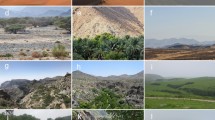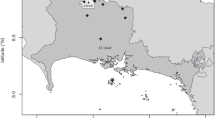Abstract
The genus Meira currently contains three recently described species of mite-associated basidiomycete yeasts from Israel and Japan and is placed in the Exobasidiomycetes (Ustilaginomycotina) Incertae sedis. A previously undescribed species of Meira was isolated from the phylloplane of a magnolia leaf in Louisiana, USA. Herein, we describe Meira miltonrushii sp. nov. and include phylogenetic analyses from three rDNA loci to resolve the placement of Meira. This study provides evidence that Meira belongs to the family Brachybasidiaceae in the Exobasidiales and supports the placement of another mite-associated yeast genus, Acaromyces, within Cryptobasidiaceae (Exobasidiales). We also examine sequences produced by numerous environmental studies that suggest Meira species can be found as endophytes of many plant species. To our knowledge, this is the first record of a member of the genus Meira in North America.




Similar content being viewed by others
References
Begerow D, Stoll M, Bauer R (2006) A phylogenetic hypothesis of Ustilaginomycotina based on multiple gene analyses and morphological data. Mycologia 98:906–916
Boekhout T (2011a) Acaromyces Boekhout, Scorzetti, Gerson & Sztejnberg (2003). In: Kurtzman CP, Fell JW, Boekhout T (eds) The yeasts, a taxonomic study, 5th edn. Elsevier, Amsterdam, pp 1603–1605
Boekhout T (2011b) Meira Boekhout, Scorzetti, Gerson & Sztejnberg (2003). In: Kurtzman CP, Fell JW, Boekhout T (eds) The yeasts, a taxonomic study, 5th edn. Elsevier, Amsterdam, pp 1833–1836
Boekhout T, Theelen B, Houbraken J, Robert V, Scorzetti G, Gafni A, Gerson U, Sztejnberg A (2003) Novel anamorphic mite-associated fungi belonging to the Ustilaginomycetes: Meira geulakonigii gen. nov., sp. nov., Meira argovae sp. nov. and Acaromyces ingoldii gen. nov., sp. nov. Int J Syst Evol Microbiol 53:1655–1664
Esteve-Zarzoso B, Belloch C, Uruburu F, Quero A (1999) Identification of yeast by RFLP analysis of the 5.8S rRNA gene and the two ribosomal internal transcribed spacers. Int J Syst Bacteriol 49:329–337
Fell JW, Boekhout T, Fonseca A, Scorzetti G, Statzell-Tallman A (2000) Biodiversity and systematics of basidiomycetous yeasts as determined by large-subunit rDNA D1/D2 domain sequence analysis. Int J Syst Evol Microbiol 50:1351–1371
Gardes M, Bruns TD (1993) ITS primers with enhanced specificity for basidiomycetes—application to the identification of mycorrhizae and rusts. Mol Ecol 2:113–118
Gerson U, Gafni A, Paz Z, Sztejnberg A (2008) A tale of three acaropathogenic fungi in Israel: Hirsutella, Meira, and Acaromyces. Exp Appl Acarol 46:183–194
Katoh K, Toh H (2010) Parallelization of the MAFFT multiple sequence alignment program. Bioinformatics 26:1899–1900
Kolarík M, Sláviková E, Pazutová S (2006) The taxonomic and ecological characterization of the clinically important heterobasidiomycete Fugomyces cyanescens and its association with bark beetles. Czech Mycol 58:81–98
Kornerup A, Wanscher JH (1978) Methuen handbook of colour, 3rd edn. Eyre Methuen, London
Kurtzman CP, Fell JW, Boekhout T, Robert V (2011) Methods for isolation, phenotypic characterization and maintenance of yeasts. In: Kurtzman CP, Fell JW, Boekhout T (eds) The yeasts, a taxonomic study, 5th edn. Elsevier, Amsterdam, pp 87–110
Lane DJ, Pace B, Olsen GJ, Stahl DA, Sogin ML, Pace NR (1985) Rapid determination of 16S ribosomal RNA sequences for phylogenetic analyses. Proc Natl Acad Sci USA 82:6955–6959
Miller MA, Pfeiffer W, Schwartz T (2010) Creating the CIPRES science gateway for inference of large phylogenetic trees. In: Proceedings of the gateway computing environments workshop (GCE), New Orleans, 14 November 2010, pp 1–8
Oberwinkler F, Bandoni RJ, Blanz P, Demlo G, Kisimova-Horowitz L (1982) Graphiolales: basidiomycetes parasitic on palms. Plant Syst Evol 140:251–277
Paz Z, Burdman S, Gerson U, Sztejnberg A (2007a) Antagonistic effects of the endophytic fungus Meira geulakonigii on the citrus rust mite Phyloocoptruta oleivora. J Appl Microbiol 103:2570–2579
Paz Z, Gerson U, Sztejnberg A (2007b) Assaying three new fungi against citrus mites in the laboratory, and a field trial. Biocontrol 52:855–862
Scorzetti G, Fell JW, Fonseca Á, Statzell-Tallman A (2002) Systematic of basidiomyceteous yeasts: a comparison of large subunit D1/D2 and internal transcribed spacer rDNA regions. FEMS Yeast Res 2:245–517
Stamatakis A (2006) RAxML-VI-HPC: maximum likelihood-based phylogenetic analyses with thousands of taxa and mixed models. Bioinformatics 22:2688–2690
Swann EC, Taylor JW (1995) Phylogenetic perspectives on basidiomycete systematics: evidence from the 18S rRNA gene. Can J Bot 73:S862–S868
Swofford DL (2002) PAUP* phylogenetic analysis using parsimony (*and other methods), 4th edn. Sinauer, Sunderland
Sztejnberg A, Paz Z, Boekhout T, Gafni A, Gerson U (2004) A new fungus with dual biocontrol capabilities: reducing the numbers of phytophagous mites and powdery mildew disease damage. Crop Prot 23:1125–1129
Tanaka E, Shimizu K, Imanishi Y, Yasuda F, Tanaka C (2008) Isolation of basidiomycetous anamorphic yeast-like fungus Meira argovae found on Japanese bamboo. Mycoscience 49:329–333
Vega FE, Simpkins A, Aime MC, Posada F, Peterson SW, Rehner SA, Infante F, Castillo A, Arnold AE (2010) Fungal endophyte diversity in coffee plants from Colombia, Hawai’i, Mexico and Puerto Rico. Fungal Ecol 3:122–138
Vilgalys R, Hester M (1990) Rapid genetic identification and mapping of enzymatically amplified ribosomal DNA from several Cryptococcus species. J Bacteriol 172:4238–4246
White TJ, Bruns T, Lee S, Taylor JW (1990) Amplification and direct sequencing of fungal ribosomal RNA genes for phylogenetics. In: Innis MA, Gelfand DH, Sninsky JJ, White TJ (eds) PCR protocols: a guide to methods and applications. Academic Press Inc, New York
Yasuda F, Yamagishi D, Akamatsu H, Izawa H, Kodama M, Otani H (2006) Meira nashicola sp. nov., a novel basidiomycetous, anamorphic yeastlike fungus isolated from Japanese pear fruit with reddish stain. Mycoscience 47:36–40
Acknowledgments
This research was supported by a National Science Foundation Assembling the Fungal Tree of Life grant (NSF DEB 0732968). We would like to thank the LSU Socolofsky Microscopy Center, specifically M. Brown and Y. Xiao, for assistance with brightfield microscopy. We would like to thank L. Urbano, M. Urbano S. Albu, A. Rodriguez, A. McTaggart, G. Heller, M. Toome, R. Kaur, M. Padamsee and especially Dr. M. Blackwell and Dr. M. Broome and two anonymous reviewers for comments on earlier versions of this manuscript; S. Gross and H. Urbina for assimilation advice; and J. Diaz, B. Kennedy, A. Smith and K. Stephenson for culture maintenance.
Author information
Authors and Affiliations
Corresponding author
Electronic supplementary material
Below is the link to the electronic supplementary material.
Rights and permissions
About this article
Cite this article
Rush, T.A., Aime, M.C. The genus Meira: phylogenetic placement and description of a new species. Antonie van Leeuwenhoek 103, 1097–1106 (2013). https://doi.org/10.1007/s10482-013-9889-1
Received:
Accepted:
Published:
Issue Date:
DOI: https://doi.org/10.1007/s10482-013-9889-1




